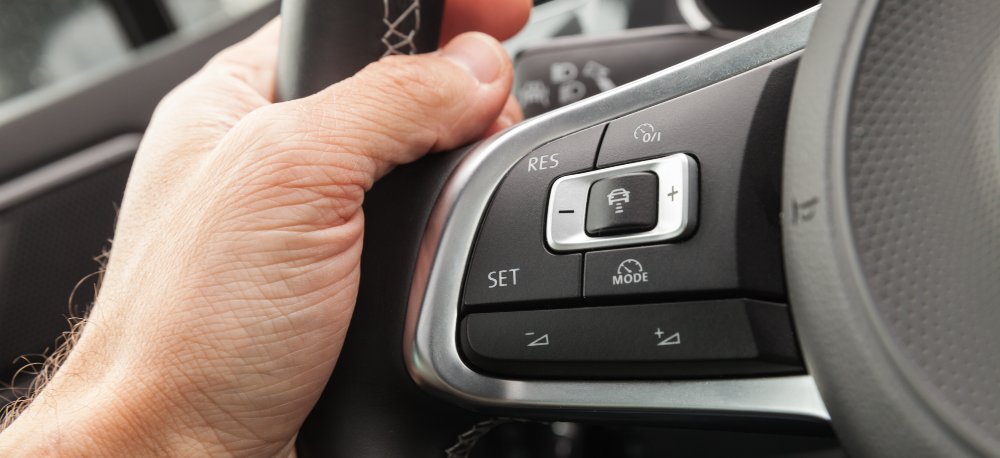Automobile manufacturers invest heavily in researching and developing technologies that keep drivers and passengers safe. This technology has multiple benefits and often assists drivers in avoiding collisions.

The Automotive Safety Council lists five eras in the evolution of automated safety technologies. Between 1950 and 2000, safety and convenience features were introduced. These include cruise control, seat belts, and antilock brakes.
The following decade saw the introduction of advanced safety features like blind-spot detection, forward collision warning, and lane departure warning. From 2010 to 2016, there was a growth in Advanced Driver Assistance Systems. These advanced driver assistance systems include autonomous parking assistance systems, drowsiness detection systems, and adaptive cruise control.
What is Adaptive Cruise Control?
According to a survey done by the National Highway Traffic Safety Administration, 94% of vehicle collisions are caused by driver error. Advanced driver assistance systems such as adaptive cruise control are used to assist the driver in potentially avoiding a collision.
Adaptive cruise control (ACC) is an advanced feature of cruise control, a system that automatically controls how fast a car is driving without the need for the driver to manipulate the car’s speed. However, simple cruise control requires the driver to slow down if there is another car in front of them (and speed up once the way is clear). With adaptive cruise control, the vehicle takes some of this work from the driver.
Once the speed is set – as with traditional cruise control – the car should automatically detect any vehicle in the lane in front of it. If another car is detected, the adaptive cruise control system should automatically slow the vehicle down. Once the road ahead is clear, the adaptive cruise control system will speed the car back up to the set cruising speed.
Adaptive cruise control may also be referred to by these names:
- Automatic cruise control
- Active cruise control
- Cooperative adaptive cruise control
- Intelligent cruise control
- Radar cruise control
Collision Repair EstimateRepairing All Makes & Models
How Does Adaptive Cruise Control Work?
Cars with an adaptive cruise control system are fitted with a forward-looking sensor that scans the area in front of the car. It works as a traditional cruise control setting, maintaining the speed selected by the driver when it is turned on. If another vehicle is picked up by these forward-looking sensors, the car automatically slows down to match the speed that the other vehicle is traveling. The car will follow the car ahead of it at a specific distance – also set by the driver.
The forward-looking sensors are either laser sensors or radar-based sensors. Laser sensors are often less expensive and relatively small. However, these sensors could be adversely affected by poor weather conditions or if the sensor becomes dirty. Radar-based sensors generally have a wider range but tend to be larger and more expensive.
Besides these differences, laser and radar-based sensors work the same way. They send a signal out and monitor how long it takes for the signal to reflect off an object in front of the car. When the adaptive cruise control system establishes that it should slow the car down, it will either engage the braking system or use the engine or transmission to do so. It will continue to slow down the car to ensure that it is keeping a safe following distance.
How to Use Adaptive Cruise Control
Adaptive cruise control systems are user-friendly. The first step is selecting the speed at which to engage the cruise control, then the desired following distance is selected. This is all that is needed to engage a vehicle’s adaptive cruise control. Drivers should remember that even while adaptive cruise control is activated, they are still in control of the vehicle and should remain vigilant and focused on driving.
Benefits of Using ACC
Adaptive cruise control systems offer multiple benefits, including:
- Lower chances of collisions through speed control and increased spaces
- Less stress for drivers while driving
- Improved comfort while driving, particularly for persons with disabilities
- Easier commutes, particularly for systems that include stop-and-go features
In addition to these general benefits, a study conducted in 2020 on the effects of automation on driver engagement found that in some cases, especially in women, drivers’ minds wander less while using cruise control.
Adaptive Cruise Control Limitations
Despite the many benefits of using adaptive cruise control, there are some downsides to chronically relying on the safety feature, including:
- Developing negative driving habits (such as higher driving speeds and aggressive braking)
- Potentially experiencing ill-time or improperly distanced stops
- Delayed braking times while the system is active
- Poor system performance during heavy rain, fog, or snow
Drivers who are well-versed in the capabilities and limits of their vehicle’s ACC system may be better prepared to handle these situations while driving, thus lowering their chances of being involved in a collision.
Conclusion
While adaptive cruise control brings some automation to driving, it is by no means a substitute for the driver. Despite the comfort drivers experience on the road by using adaptive cruise control, they should still stay vigilant and ready to react if necessary.
If you do end up in a collision, Gerber Collision & Glass is ready to assist. With more than 80 years of car frame and body repair experience, every Gerber shop is staffed with professional technicians who deliver expert advice and customer service.
Call Us Now at 1-877-7GERBER or Schedule an Appointment Online!






